Have you always been attracted by the ancient beauty of sunny Greece, washed on three sides by azure seas? Have you been on vacation to this hospitable land more than once and are forever captivated by its landscapes, people, elegant monuments and romantic myths? Then a wedding in the Greek style, decoration of the hall like an antique temple, appropriate outfits, music and menu are just for you. This is a great idea for a summer celebration, turning the standard wedding process into a beautiful and graceful ceremony.
Traditions and features of a wedding in the Greek style
When organizing a wedding in the Greek style, it is important to pay attention not only to the images of the bride, groom, guests and the decoration of the hall, but also to the traditions of the people. Then the theme of the celebration will be respected from start to finish.
In the past, the classic Greek wedding involved a three-day celebration. On the first day, the bride and groom entered into a civil marriage, and then spent time in the company of their parents and close relatives. On the second day there was a wedding, which the newlyweds celebrated in each other’s company. On the third day, a noisy party was thrown, relatives, friends and neighbors were invited.
Modern Greeks set aside just two days for the holiday, to first celebrate with family and then with friends. A day for just two is postponed for the honeymoon.
Features of Greek weddings:
- Greeks prefer to get married outdoors, so give up the registry office in favor of on-site registration;
- Bride ransom is a tradition that is also popular in Greece, but the tests for the groom are thought out on the basis of ancient myths;
- broken dishes - for a strong, long and happy marriage, so the bride and groom must break a plate each during the holiday;
- the first dance of the newlyweds should take place surrounded by guests who hold hands and dance in circles;
- the louder the better: the Greeks are a noisy people, during the holiday they try to tell everyone what is happening, so shout, sing, stomp, clap and do not forget to honk on the roads.
Traditional Greek wedding
It starts on Saturday. On this day, according to tradition, the groom must make a sacrifice to the gods - slaughter a sacrificial lamb and cook a roast on a spit. As soon as the groom copes with this difficult task, the bride's dowry is ceremonially transported to his house. And the newlyweds go to wash together to cleanse themselves before the Sunday wedding.
On Sunday morning the wedding itself begins. The guests sing songs, solemnly dress the groom and go in procession to the bride's house. Her mother meets the guy at the door with wine and baked goods. He must eat and drink everything, and then ask for blessings. The woman kisses him twice, after which he becomes a relative.

Bride ransom
The girl is dressed in wedding robes. While the groom buys the right to enter the house, the chosen friend presents the bride with white shoes - these are the ones she will wear to get married. The bridesmaids try to steal the shoes, and the bride tries to find them. She must dance with her father, after which the groom has the right to take her out of the house. The girl resists with all her might. And the newlywed must prove his strength and perseverance and still bring out - or carry out, as it turns out - the obstinate bride.
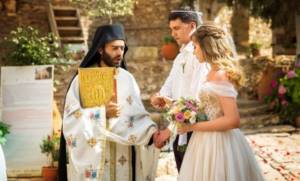
Wedding
The newlyweds go to the temple in separate processions. The groom must be the first to reach the wedding venue and wait for his chosen one at the entrance. It is led by a close male relative, father or brother. Moreover, traditionally, they do not approach the door right away, making several circles around the surrounding area: they make the groom and his relatives nervous.
The wedding takes place solemnly, the decoration of the church includes many flowers and candles. At the end of the ceremony, the newlyweds are sprinkled with rice. And guests are offered small fabric bags with sweets. Young people are given gifts.
Visiting my husband's house
After the wedding, the newlyweds go to their husband’s house, where their mother-in-law is waiting for them. She greets them with sweets or honey, as well as loaf of bread. On the threshold, she hands over a pomegranate fruit, which since ancient times has symbolized wealth and well-being. Young spouses must cross the threshold only with the right foot and at the same time, which means harmony and family happiness. There is also a custom when gold coins are placed in the mouths of the husband and wife who enter the house. From now on, they should utter only words as beautiful as gold.

Interesting wedding ritual customs
A wedding in Greece is filled with amazing rituals and beliefs.
- On the wedding day, the girl writes the names of her girlfriends on the soles of her white shoes. Whose name is erased will marry faster than others.
- The groom should not see her wedding dress until the morning of the wedding.
- When a bride bakes a wedding loaf, they try to sprinkle it with flour. It is believed that ignoring this custom will leave the family to languish in poverty.
- If on Saturday the groom was unable to personally slaughter a lamb and cook a meal on a spit, he will turn out to be a useless family man.
- On Sunday the groom is not allowed into the house for a long time. As compensation, he must have a chicken with him.
- During the dances, many gold crosses and paper money are attached to the newlyweds' outfits.
- The bride's dance, according to custom, takes place surrounded by unmarried guys. The girl throws her handkerchief. Whoever picked him up first is the first contender for a quick marriage.
- One dish must certainly be broken by a person with a pure heart, for good luck.
The wedding feast begins in the evening after the wedding and sometimes lasts three days. The evening opens with a dance of the young people, during which they are showered with money. During the walk, the newlywed should draw water from a fountain or spring and treat those present. This is an ancient tradition that symbolizes fertility.
Ideas for places to celebrate
Having a wedding in sunny Greece is a fairy tale. Just imagine ancient narrow streets, green gardens, majestic churches and monasteries, as well as endless white beaches and a blue, clear sea... Most popular destinations:

Santorini

Rhodes

Crete

Corfu

Mykonos
A marriage entered into in Greece will have legal force throughout the world. If desired, the newlyweds can organize a wedding according to Orthodox traditions in any of the Orthodox churches.
But if traveling to Greece is not an option, but you want a Greek wedding, then you can try to find an establishment that adheres to the chosen theme in both the design and the menu. It is usually beautiful, tasty and atmospheric there.

And creating the right ambience for a Greek wedding is not so difficult. Go to the sea or the countryside, order an arch decorated in accordance with the chosen theme, and enjoy the celebration in the fresh air.
READ ALSO: Stylish wedding picnic – impressions of the bride

To enhance the experience, we recommend inviting musicians to play traditional Greek melodies, or preparing a playlist in advance. Another must-see is Greek cuisine.
Wedding in Greece: about traditions and preparation
A wedding in Greece will be a smart decision if you want to hold the ceremony abroad. While Italy, Spain and France “bite” the cost of renting castles, villas and other wedding venues, Greece attracts newlyweds with its incredible views and reasonable prices for holding a celebration.
UNASSVADBA: Maria, hello! You have extensive experience in holding both mini-weddings in Greece for two, and “traditional”, in the Russian sense, weddings with a large number of guests and relatives. Which cities are popular there? Are they going to the islands?
Maria Kichigina: Julia, hello! Thank you for contacting me with this question. Our newlyweds in many cases prefer Greece to most countries when choosing a wedding location. In fact, mainland Greece is less popular than the islands. Most newlyweds want to go there. The most popular among them are Crete, Rhodes, and, of course, Santorini, which deserves a separate interview about itself. Santorini is the most wedding-friendly of all the Greek islands. Its landscapes and views are very attractive for a romantic ceremony.

White-stone houses, azure roofs of churches, breathtaking views of the sea with cruising liners and yachts... Many different viewpoints for ceremonies - there is no other island with so many interesting wedding locations. But in connection with this, there is a large flow of newlyweds who come here from all over the world. The summer months are a busy wedding season and some venues even get booked up years in advance for a specific date. But even if you have a sudden decision about a ceremony in Santorini, we will try to help you. We are constantly searching for the most interesting and new venues that have not yet been conquered by a large flow of weddings. At Marry Marry, we promptly (one of the first) receive information about new products on this fabulous romantic island.
But we do not ignore other Greek islands. Each of them is unique and has its own advantages, incomparable with other places.

U: What wedding traditions exist in Greece?
MK: A Greek wedding is full of traditions and rituals. Some of them are quite applicable in Russia and are similar to our celebrations. As an example, before the wedding ceremony and immediately after it, in Greece it is customary to organize a “concert” of honking cars. And, as in Russia, the Greeks like to celebrate a wedding not just on one day, but on several. But if in our country it is traditionally two days, then in Greece it is three. Of course, every day is scheduled and corresponds to a specific program, which was not invented by the newlyweds, but developed historically! Usually the celebration starts on Saturday and ends on Monday.
And of course, you can’t escape the fun and noisy Greek dancing! The newlyweds begin to dance the first dance together, and then the guests join them, forming a circle and placing their hands on the shoulders of their neighbor - the traditional sirtaki dance.

We try to use the local traditions of the country as much as possible at weddings for Russians. And we almost always arrange a master class on sirtaki for guests and newlyweds by specially invited professionals. This is one of the most striking and memorable parts of the celebration.
U: Is a marriage concluded in Greece valid in Russia?
MK: yes, of course! And the procedure is quite simple! We help our newlyweds on all issues related to the process of official marriage in Greece.

U: Is it possible for residents of Russia to officially get married in Greece?
MK: You can too! The majority of Greeks are Orthodox, and, in connection with this, there are a large number of Orthodox churches on the mainland and islands. Unlike Russia, the Greeks attach the greatest importance to religious marriage. For them, a wedding is much more important than all the bureaucratic procedures.
U: how much does a wedding in Greece cost?
MK: it all depends on the number of guests, the chosen venue, the content of the wedding and many other various factors. But, if we are talking about a wedding for two, then the cost of the official ceremony starts from 2000 Euros. This amount will include all services for the legalization of an official marriage, transfers for the newlyweds, the bride’s bouquet, and even the wedding cake. Greece is definitely one of the most budget-friendly countries for a wedding.
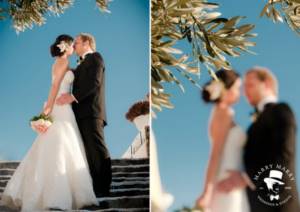
U: Which couples choose Greece for their wedding?
MK: Greece is chosen by romantics and traditionalists, couples who want crazy fun and noisy celebration. And also, it seems to me, couples for whom family values are important, since in Greece relations between relatives are very warm and friendly.
U: What is usually served at Greek weddings?
MK: The traditional wedding table in Greece is meze. Mezes are small Greek appetizers that are not served individually, but placed in the middle of the table so that each guest can choose an appetizer to suit their taste or try a little bit of everything. Traditional Greek snacks include olives, feta cheese, the well-known “Greek salad,” dolma, vegetable pastes, and beans. And after the meze, hot dishes are served. They are served in the same style, in the center of the table and for all guests at once. The most popular type of meat preparation is souvlaki. Pieces of meat on skewers, almost kebab. Served with white bread and lemon. And, of course, fish and the freshest grilled seafood in large quantities.
For lovers of a traditional wedding banquet in our country with individually served dishes, there are also such places.

U: How is the celebration going?
MK: for Russians there are no significant differences in the wedding day scenario. Morning preparations for the bride, photo shoot, ceremony, banquet and beautiful end of the celebration with cake and fireworks. But of course, adjusted for the country and its climate. During the summer season, the islands are very hot. Therefore, we recommend holding the ceremony no earlier than 18.00 to avoid the scorching sun. And not only him... Everyone knows that for the beauty of the picture, it is better to do a photo and video session in the setting sun than in the zenith sun! This is also very important! Although, for us in Russia, a ceremony after 18.00 sounds strange, at this time we have long been accustomed to being at a wedding banquet... But our employees, who every time accompany the newlyweds and their guests to Greece for the celebration, know exactly how best to set the timing wedding day, taking into account local features.

U : What attractions should you visit on your honeymoon?
MK: each island has its own attractions, some have more, others have less. But I advise newlyweds to travel to different parts of Greece. After all, everywhere has its own characteristics. There are sea communications of quite satisfactory quality between many islands, so there are no barriers to this.

U : How far in advance do you need to apply for marriage in Greece?
MK: we advise our newlyweds to bring us documents for subsequent legalization in Greece no later than 2 months in advance. Although, there were also urgent cases when everything had to be done in extra-fast mode, in less than a month.
U : How long does it take to prepare a wedding abroad?
MK: usually our newlyweds make a decision about getting married abroad at least six months in advance. This is due to the fact that they need to notify all relatives and friends, book comfortable flights for them, and choose a hotel to stay in advance. If our wedding involves only the bride and groom, then the newlyweds apply in less time, although in this case the choice of wedding venues is reduced... It’s still better to hurry.

U : tell us about the Greek weddings that you had to organize (previously, Maria headed the wedding agency “My Wedding Planner” - editor’s note) .
MK: We have experience organizing weddings in most wedding destinations in Greece - Santorini, Rhodes, Crete, Athens and Chalkidiki. All these weddings are very different, both in the number of guests, and in content, and in content. But in general, what they all have in common is that they are organized on the territory of a very warm, cordial and hospitable country.

U : Maria, you launched a new brand, Marry Marry . How did the idea come about? What are your plans for the coming year?
The idea of a brand arises through endless weeks of sleepless nights J But every time I understand that this time is worth it. As soon as I see the result. This is not the first, but already my third brand in the wedding business. And, fortunately, I know that the new brand brings me even more new knowledge, skills, experience and opportunities for self-realization. And, most importantly, it becomes more successful than the previous one. Therefore, our plans for the coming year are to become even better and make even more people happy. And give them the opportunity to feel the state of euphoria on the most important day, wherever it may be, in Russia, Greece, New York or Zanzibar... We can control any geography.
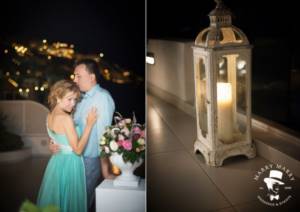
U : what do you wish for the brides?
MK: don’t be afraid of your strangest ideas regarding the geography of the wedding or the content. We, wedding planners, will be happy to support you in any endeavor and recommend the best option for you. And we will do everything to make you feel like a carefree princess on your wedding day!
Author: Yulia Chernaya
Photos courtesy of wedding agency Marry Marry
Bride's image
Since the main attention of the guests falls on the young, especially the bride, you need to carefully think through the image based on the theme of the wedding. The Greek version is not the most difficult, follow our tips and your image will match the celebration.
Makeup and hairstyle
Greek hairstyles are curls along the entire length or complex braids pinned to the back of the head. Hoops, tiaras stylized as a laurel crown, and flower arrangements are used as decoration. A veil is not needed, but if you really want to, it’s better to choose the short option

When making makeup, focus on eyebrows and eyes, as Greek women usually do. The color of eye shadow and eyeliner is determined individually, but the most popular are brown, sand and golden shades with small black arrows. We recommend using a highlighter to create a glowing effect. Nude matte lipsticks look great on the lips.
Dress
Grecian style wedding dresses have a straight cut and high waist. They are sewn from light fabric, mainly silk and chiffon. The main color is milky white, with golden elements used as accents, for example, a belt under the bust.
It is important to list the advantages:
- Versatility: Greek-style dresses suit all girls, regardless of body type and size, and because of the high waist, such options are often considered by brides in an interesting position.
- Lightness and comfort: during the celebration, the bride will not get tired of carrying fluffy skirts that constantly drag on the floor, she will be able to dance freely, participate in entertainment, and all this without changing her outfit in the middle of the celebration.
- Originality: lush wedding dresses are a classic, but if you want to create a unique look, then first of all pay attention to the Greek style.

Shoes
The image of a Greek goddess is the perfect excuse not to buy heels and spend the entire wedding at ease. When looking for shoes, look for gold and silver sandals with thin soles, perhaps decorated with ribbons or stones.
But high heels are not prohibited, it is only important that they be elegant. The best option is hairpins. Look for open-toe shoes or sandals, ideally as open as possible to show off a woman's feet, and with plenty of straps.
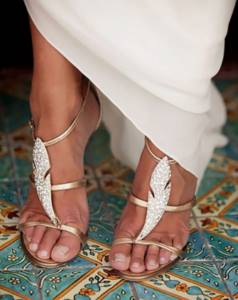
Accessories
In the Greek image there is only gold jewelry. A hoop or stylized tiara for the hair, large bracelets for the wrists, forearms and shoulders, massive earrings. It is appropriate to follow the theme of the laurel crown and choose accessories with floral patterns.
Helpful tip: Leave the neck bare to highlight the length, fragility and exposed collarbones.

Bridal bouquet
Grecian style wedding bouquets don't tolerate bright colors, so focus on pastel shades. To maintain the theme, we recommend choosing those flowers that appeared in myths, for example:
- roses - white symbolize innocence and purity, red love and passion, and the patroness of flowers is the goddess Aphrodite;
- peonies - created by the gods in honor of the talented healer Peon, associated with good health and well-being;
- lilies are the flowers of the goddesses Hera, the wife of Zeus, and Persephone, who was responsible for fertility;
- asters - were associated by gods and people from myths with unattainable stars, and were given as a sign of strong love;
- irises are a symbol of joy, their patron goddess is Iris, who also created a bright rainbow.
READ ALSO: Key points of organizing a wedding in ECO style

As a supplement you can use:
- myrtle;
- ivy;
- olive;
- ruscus;
- eucalyptus;
- fern.
Gerberas, chrysanthemums, alstroemerias and orchids are never used in Greek bouquets simply because they are not available in the country.
Make your choice
[justified_image_grid ids=”6160,6161"]
[v[vote2x id=»6162" align=»center»]p>
Current trends
Wedding dresses in the Greek style can rightfully be called a real masterpiece in the world of wedding fashion. The collections of the world's leading designers present various models. The following fashionable “tricks” can be distinguished: armholes on one shoulder, too high a waistline, asymmetry of the bottom and top of the dress.
A dress model with a high waist, a long hem, consisting of many layers of light flowing fabrics, and a bare shoulder are very popular in 2020-2021. Nobody notices any flaws in the figure, even if they exist, fixing their gaze on the seductively alluring bare shoulder. This is exactly what Greek dresses from Elie, Saab, Valentino look like.

However, symmetrically made dresses look very interesting. Models with a classic high waist and criss-cross drapery on the chest will also be relevant.

In 2020-2021, designers and stylists offer girls both dresses without straps and with thin straps.

The model with a train looks very nice. Skillful cut, correct selection of fabric, exquisite simplicity make the dress truly elegant and divine.

Do you want to be on trend? Choose a dress that is strapless or has a one-shoulder opening. This is a bold and bright option. The second strap can be light lace or a chain of pearls - your imagination is not limited to anything.

Marc Jacobs and the House of Chanel offer brides a chiffon Grecian dress, made in the style of a tunic, with leather sandals, Monique Lhuillier and Malandrino - dresses in a Greek style, decorated with jewelry.
Bridal salons offer a wide selection of different dress models. You can also sew a dress to order. Then you can take part in the real magic yourself - creating a goddess dress.
Groom image
No one forbids the groom to order a Greek chiton and chlamis from the studio to match the bride, but you can limit yourself to an ordinary classic suit. Tuxedos in milky, beige and cream shades look most organic.
And if you want to create a relaxed image, then you can skip the jacket. In this case, the shirt should be short-sleeved, and as a fashion accessory – suspenders, which modern Greeks simply adore.

Dress code for guests
It is important to notify guests in a timely manner that the wedding will have a Greek theme, otherwise they will not have time to choose the right outfits. As a recommendation, you can send out a color scheme and list colors that should not be used. For example, the Greeks consider green a mourning color, and during holidays they try to avoid it.
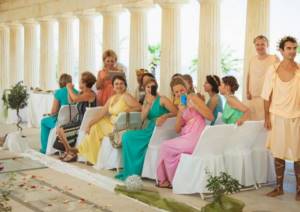
In general, the same rules apply for guests as for the bride and groom. Women choose summer dresses in the empire style, men choose light suits. If desired, you can order a traditional Greek chiton with a cloak.
The history of marriage and its origin.
Marriage as we know it has a long history, with roots going back centuries and originating from ancient cultures. It would be right to delve into the history of the union between a woman and a man, which is now a legal institution, regulated by family law, and protected by the Constitution as a fundamental element of our society. We will go back in time to understand the path of customs and rules that make up marriage. Let's try to understand the differences between marriages of the three great monotheistic religions: Christian, Jewish, Islamic.
Marriage in Ancient Greece.
In marriage during the civilization of Ancient Greece, the bride and groom did not choose each other and did not make marital vows. The bride was "didomi", which in ancient Greek means "to give" or better "ekdidomi", that is, "given" to the groom, because women were not free and could not provide for themselves, but lived under the guardianship of the father or a close male relative. After marriage, the husband became the guardian and in the event of the latter's death, guardianship passed to the son. The marriage had meaning only when the delivery of the bride was carried out by a guardian who had the right to do so. After delivery, the bride remained passive and her consent was never asked during the ceremony. The wedding promise was conditioned by the legitimacy of the marriage itself. The woman was essentially a concubine who could not give her consent. This was a kind of marriage contract - a promise between the bride's father, who offered a certain amount, and the future groom responded by accepting the offer. So the father of the bride and the groom ratified the marriage contract. After this, no rituals were performed and the father took his daughter to the groom's house and paid the dowry. After the delivery of the bride, the ceremony began, which took place in the presence of relatives and friends present at the holiday, for whom the groom organized a banquet. In the evening, the mother accompanied the bride to the bedroom and handed her over to the groom. In ancient Greece, a young woman had to marry a man chosen by her guardian, and this choice always depended on the economic and social status of the families. Often in families with high social status, it was preferred to arrange marriages between relatives in order to consolidate wealth. At that time, there were some prohibitions on marriages between blood relatives. In fact, a person could not marry his own stepmother, or stepdaughter, or mother-in-law, or daughter-in-law, and, with few exceptions, he could not even marry his own sister. In some cases, a marriage with a sister was allowed, that is, with a daughter from her father’s second marriage, and sometimes a marriage with a niece was allowed. A Greek woman could get married at the age of 15, and a man at the age of thirty. The woman had her own reasons for her early marriage - she had to give birth to many children who would be defenders of Greece. The fact that men married later in Athens can be explained by the need to serve in the army for ten years, and also to compensate for the smaller female population than the male one. A young widow, in fact, could enter into a marriage contract for a certain number of successive marriages, and a husband who was dying or about to divorce could provide for his wife's future.
Marriage in Ancient Rome.
In the Roman world, the wedding had a significant social function, since it formed the basis of the “Familias” (family), which, in turn, was the unit of “Civitas” (society). Marriage was thus seen as a factor of stability and survival for all Roman society. This decisive social meaning does not correspond primarily to the legal meaning of marriage. At the beginning of the Republican period, in fact, marriage had a primarily religious meaning and patrician marriages were accompanied by a ceremony full of religious meanings and symbols. The process that led marriage to recognition as a legal institution was very long and ended only in the 5th century BC. e. During this long process of transformation, there were several significant innovations until the so-called "manus maritalis" (one of the laws of Roman law) was created. According to this law, the groom acquired power over the bride at the time of marriage. According to this law, the groom, and then the husband, acquired full power over the woman, who, in turn, destroyed all legal ties with the family of origin and became part of her husband’s family.
In the last stages of the Republican era, a new legal category of marriage began to be practiced, which closed the "manus maritalis" and moved to "matrimonium sine manu". According to this practice, if a woman, during a year of marriage, was away from her husband’s home for three nights in a row, then he could not exercise “manus maritalis” over her. The repeal of the law regarding husband's authority over wife was not implemented in favor of the woman, but as a legal agreement created to benefit the woman's family of origin for economic reasons. Essentially, blood relatives exerted authority over a woman even after she tied the knot, especially in the case of acquiring property that would otherwise have come under the authority of her husband. It must be admitted that after this, women gradually acquired freedom of action and were no longer subject to the legal protection of their husbands. In order for a marriage to have legal force, the mutual consent of the spouses would have to be obtained when both were of sound mind, otherwise the marriage would not be concluded. With the advent of the Imperial era, the legal form of marriage did not undergo significant changes after the Republican period, and laws passed by Emperor Augustus focused on reform projects in favor of the family. This emperor of the Roman Empire actually sought to create new families by providing assistance for large families and, conversely, increasing taxes on those who decided to remain single. Marriage in ancient Rome was planned by the fathers of the couple, who discussed the future wedding only at the time of the betrothal of the bride and groom. The time, place and rituals for the wedding depended on the deities that the families worshiped throughout their lives. The bride dressed in a white dress for the wedding, and her head was covered with an orange veil, on which was placed a wreath of flowers. The only legally recognized marriages were those between Roman citizens. Mixed marriages were considered invalid and descendants born in this marriage were considered illegitimate. In the case of a marriage between slaves, the owner had the right to express his consent to the marriage or to deny it, and could also dissolve the marriage. A real revolution in marriage law came with the advent of Christianity, and with its spread certain important legal changes were introduced. Marriage, in the Christian understanding, was considered a sacrament, with a subsequent denial of divorce, very common in the Roman Empire. This new idea of a union between a man and a woman led to a gradual change in the legal form of marriage and was no longer seen as a "legal transaction" based on the will of the spouses, but as a "legal relationship" based solely on the original consent of the spouses to live together, therefore from this consent the legality of marriage was established.
Marriage in the Middle Ages.
After the fall of the Roman Empire and the invasions of the barbarians, Christianity began to be established throughout Europe, the way of life of people began to change, and with it, marriage laws. In 534 AD e. Roman Emperor Justinian declares sex outside of marriage between a man and a woman illegal. Since then, the Code of Justinian has become the basis of all European marriage laws. With the fall of the Roman Empire, the signing of a marriage contract was abandoned and this marked the beginning of multiple illegal marriages, similarly, secret marriages and divorces became very common. In the Middle Ages, at the Lateran Conclave in Rome in 1215, the Catholic Church declared the sacramental nature (sacrament) of marriage between Christians and established the following principles of marriage:
- the use of publications to avoid secret marriages is prescribed;
- the concluded marriage was legally indissoluble even in civil law, with the exception of the death of one of the spouses, in order to avoid divorce;
- it was ordered that the consent of the spouses be expressed publicly and in a public place to avoid kidnapping for marriage purposes, even if in those days the church condoned violations committed against the woman's wishes;
- a minimum age for spouses was established to prevent marriages with children, as well as to prevent girls from marrying old men;
- a marriage could be declared invalid if one of the spouses was forced or kidnapped, there was violence, lack of marital relations, secret marriage, etc.
These laws were adopted for civil marriage, which was established in France in 1791, during the French Revolution.
Marriage in the modern era. Since the Protestant Reformation, in the United States of America, where the reformist Christian religion was chosen, marriage has become possible in a state institution. Since 1600, many Protestant countries in Europe began to experience massive government intervention in marriage legislation. In Catholic countries, however, the statements of the Trentian Conclave were established: the marriage ceremony must be performed before a priest and witnesses, and a record of this must be kept in the registry of the ecclesiastical district. It was decided to ban cohabitation outside of marriage.
Modern marriage.
In 1875, Chancellor Otto von Bismarck introduced in Germany, “Zivilehe”, that is, civil marriage; until that time in Europe, only the church could formalize a marriage by registering it. The introduction of the "Zivilehe" was the first step towards the separation of church and state, which led to a decline in the function of Christian churches in Germany. This law established that the marriage union can be broken only in the event of the death of one of the spouses or the annulment of the sacrament of marriage, or the dissolution of the marriage contract by the parties at their request. Other changes were implemented after World War I:
- minor children, in most cases, had to live with their mother in the event of divorce;
- it was the responsibility of the bride and groom to give support to their spouse;
- punishing a husband towards his wife was considered a crime;
- own children born out of wedlock acquired the same rights as legitimate children;
- rape of one's own wife was punishable by law;
- property acquired during marriage became family property and, in the event of divorce, was divided equitably after judicial separation.
In Italy, the couple had the opportunity to freely decide before the wedding which property regime to choose: common or separate property.
Curiosity and superstitions about marriage.
Marriage, being a very important moment from a social point of view, is a rite that over the centuries has become overgrown with rituals, symbolic expressions, rules and some beliefs. Here are some traditions that Italians necessarily adhere to in marriage rituals. Five mandatory rules for what a bride should wear on her wedding day:
- one new thing that symbolizes the beginning of a new life;
- one old thing to indicate the value of a past life, which will be transferred to a new life;
- one thing borrowed from someone: symbolizes the true feelings that follow you in the life that awaits it;
- one donated item symbolizes the love of loved ones;
- one blue thing: to show the purity of the bride’s feelings.
In later times, one more rule was added to these five rules: wear something red, so that the passion between spouses lasts for a long time. As for the groom: there is a tradition that the bride must cross the threshold of the new house hand in hand with the groom. This custom comes from ancient Rome; in fact, it was considered bad luck if the bride tripped on the threshold. Many also follow customs associated with marriage and which are preserved for several generations, as talismans for the married life of the bride and groom. One of these talismans is the bride's bouquet. This is the last gift from a man as a groom, which at the end of the wedding ceremony the bride throws to her unmarried friends, and the one who can catch will definitely get married within a year. The same can be said about the garter. The tradition of throwing a garter comes from the distant 14th century and stems from the belief that whoever receives a piece of a wedding dress will receive good luck. In the seventeenth century, unmarried men wanted at all costs to obtain a wedding dress cap to hang on their hat as a sign of good luck. Over the years, this custom was supplanted by the launch of the garter - the groom was supposed to remove this accessory from the bride and throw it to his unmarried friends. Another tradition associated with the garter is to cut it into small pieces and give it to all your bachelor friends. In some parts of Italy, the tradition is still followed of cutting the groom's tie into small strips and offering it to the invitees in exchange for money, which will be given to the newlyweds. Let us now dwell on a very famous proverb, “wet bride, happy bride,” which we have often heard without understanding the true meaning. It may seem that the famous proverb was born to reassure all the brides who expect good weather on their wedding day, but in fact it is due to the fact that rain in the past was considered one of the key elements for the growth of cultures and for everyday life. The abundance and fertility of the land was associated with the abundance of rain. What better omen for marriage than plenty of rain? In addition, there are many superstitions, as well as curious customs associated with marriage and which were collected from all parts of Italy:
- a wedding ring should be worn on the ring finger to preserve love;
- the bride should not look in the mirror on her wedding day in a dress unless she takes off one earring or glove;
- it is bad luck to wear a wedding ring before the wedding ceremony;
- You should never buy wedding rings for the wedding and an engagement ring for the bride on the same day;
- spouses should never see each other the day before the wedding;
- the groom should never see the wedding dress before the ceremony, otherwise he will receive great misfortune;
- if the groom has already left the house to go to church, under no circumstances should he return back along the same road;
- do not marry and never start a journey on Tuesday and Friday, because Tuesday is the day of Mars, the god of war, and evil spirits were created on Friday;
- if the wedding ring falls, then the one who conducts the wedding ceremony must pick it up;
- never get married in May, as it is considered an ominous month.
Almost everyone claims that they do not believe in these superstitions, but there are no spouses who do not follow certain traditions or do not attach importance to good appearance so as not to attract possible bad omens.
Catholic rite and consensual marriage.
Catholic marriage is considered a sacrament that has four bases:
- freedom: in the sense that spouses should be free when they decide to legitimize their relationship by marriage;
- fidelity: this means that the spouses must pledge eternal fidelity until death do them part, in good times and in bad, in sickness and in health, by promising mutual assistance to each other;
- indissolubility: this means that the sanctity of marriage makes the union an indissoluble covenant of communion;
- fruitfulness: in the sense that the spouses agree to lovingly accept the children God wants to give them.
As a result, Catholic marriage does not allow divorce because it would be considered a betrayal of God's covenants. Only in certain cases can an ecclesiastical marriage be declared invalid as if it had never taken place, but this annulment must only be ordered by the ecclesiastical court of the Sacra Rota. After centuries of Catholic presence in Italy, ecclesiastical marriage allows the faithful to achieve a double benefit through a single ceremony - it has legality before the church and the state. This type of marriage is called a consensual marriage and is the most common religious ritual in Italy. It also provides the opportunity for believers to receive double legal validity of both religious and civil rites, provided that the certificate drawn up by the priest is also registered in the civil registry. Without this transcript in the public registry, the marriage will remain only a religious attachment that does not produce civil consequences. For the Italian state, these spouses acquire a de facto family and will not enjoy all the de jure rights that the conclusion of a civil marriage gives: • acquisition of the husband's surname by the wife; • mutual rights of inheritance; • common property; • mutual rights and obligations; • the legality of the birth of children in marriage, of course, provided that they have maintained an open marital status. Conversely, a Catholic who has entered into a consensual marriage, if he chooses to divorce, will be considered free to the state but married to the church. To conduct an agreed-upon ceremony according to the Catholic ritual, you must select a church and post about it. After this, both future spouses must attend “premarital” courses, which last about two months. At the end of this course, the bride and groom will receive a certificate, which must be included in the documents in order to obtain a marriage license. We must also remember that the Catholic Church imposes restrictions: the ceremony is not allowed during Advent (four weeks before Christmas) and during Lent. It is also necessary to have witnesses, at least two, but not more than four. They sign the marriage certificate together with the spouses and these signatures give legal force to the marriage.
Marriage under other religious rites with civil effects.
Italy is a state that recognizes the civil validity of religions other than the Catholic one, provided that the denomination has entered into an agreement with the Italian state. The religious denominations that have entered into the covenant to date are:
- Tavola Valdese;
- Italian Union of Seventh-day Adventists;
- Italian Union of Jewish Communities;
- Assembly of God in Italy (ADI);
- Baptist Church;
- Evangelical Lutheran Church in Italy.
Protestant wedding ritual.
The Protestant marriage rite rejects the sacramental character (sacrament), considering marriage a union of life. Protestants view marriage as a personal choice between two individuals who decide to start a family. The Protestant ceremony is very simple and indicates the spiritual depth of the couple's choice. During the ceremony, the couple announces their choice of life and faith. Only then does the pastor pronounce the blessing of the spouses.
9. Orthodox wedding ritual.
The Orthodox rite is one of the most memorable wedding ceremonies due to its scenographic and symbolic nature. Marriage can be celebrated only on certain days (this is written on my website on the page: wedding according to the Orthodox rite). Future spouses must arrive together at the church where the wedding sacrament will be held. Before the ceremony begins, the groom goes to the bride's house and, for a nominal fee, “buys” his bride from male relatives. And the bride, in turn, gives her future husband clothes sewn by her. The wedding ceremony consists of two moments: betrothal and coronation. An Orthodox wedding means that the bride and groom get engaged and get married on the same day. The first moment of the ceremony is represented as the betrothal, during which the bride and groom enter the temple with their witnesses. The priest blesses the bride and groom three times and offers them a lighted candle, whose light (symbolically) will guide them to the altar, where they will find their rings: gold for the groom, silver for the bride. The priest will give these rings to the newlyweds after he crosses the heads of the bride and groom three times. The second part of the ceremony is represented by the coronation, which is celebrated next to the "Tetrapodion" or small chest of drawers, where the newlyweds will find a cup of wine and two crowns of flowers or leaves. In some cases, they may be decorated with gold and precious stones. These crowns will be placed by witnesses on the heads of the spouses while the priest blesses the cup of wine. Then the priest will give the spouses three glasses of wine to sip, and after they announce their “yes,” they will have to walk around the altar three times. After this, the couple will be connected by a ribbon, which symbolizes the union, and the spouses must dance a symbolic dance. At the end of this dance, the priest invites the couple to kiss. A marriage according to the Orthodox rite in Italy will be considered valid, but it is only necessary that the spouses be registered in a civil marriage.
Jewish wedding ritual.
The Jewish religion provides different types of marriage, specifically there are three types: "kesef", "shetar" and "bi'ah". Today the most practiced is without a doubt the "kesef", which stipulates that the marriage must be celebrated in the presence of a rabbi and witnesses in order to ensure that the contract is concluded through the wedding ceremony. In fact, the laws that govern Jewish marriage are inflexible and must be followed to avoid harsh penalties, including financial ones. There are only two of these laws named during the ceremony: the law of Moses, that is, the Torah and the law of Israel. The Jewish marriage ceremony, which has some very interesting features, is not considered a sacrament, only a covenant blessing. In this religious rite, marriage is considered a public act in which a woman is given to a man and the family that will be the result of their union. In a Jewish marriage, it is obligatory for the bride to follow the path of purification, which is called "Mikve" and represents the covenant between God and the Jewish people. The ceremony itself is divided into two parts: • "Kiddhushin", which represents the moment when the groom gives the ring to the woman he wants to marry, along with gold coins in front of witnesses, repeating the ritual formula, • "Nessu'in": in the second stage, the wine poured into cups is blessed and offered to the newlyweds. This phase of the ritual marks the beginning of the couple's cohabitation. For some time these two phases of the ritual were combined. In the Jewish religion, not only the synagogue is the place to hold a wedding ceremony, you can also hold it in your own home or in an open place. As a rule, the ceremony is performed by a rabbi, but his presence is not required. The only requirement is that there be no obstacles and that everything be organized in accordance with the tradition of the ritual. This verification will have to be carried out by the head of the Jewish community. One of the basic rules about the legality of a marriage is the presence of at least ten guests, without which the wedding ceremony will not be valid. A Jewish marriage begins with a cortege, which continues until the bride and groom enter the same room to begin the civil ceremony. Here the rabbi begins to read the Ketubah, that is, a contract regarding the husband's economic responsibilities towards his wife, and which aims to protect the interests of his wife in the event of divorce. In the Jewish religion, in fact, the ability to demand a divorce is the prerogative of only the husband, who, in case of such need, must pay a certain amount of money to his wife to enable her to live with dignity after the dissolution of the marriage. After reading the contract, the husband who signed the document gives it to his future wife and together the spouses receive a blessing. After receiving the blessing, the couple approaches the "huppah", a red velvet canopy enriched with gold embroidery, which is their new family home. In the center of the synagogue, the newlyweds will drink wine from a cup prepared for them and the groom must give the bride a wedding ring. The bride does not give any ring to the groom and silently expresses her consent, without reciting words. During the reading of the seven blessings from the Torah scroll, the rabbi covers the heads of the spouses with his talleth. At the end of the ceremony, the groom breaks a glass, which symbolizes the destruction of the Jerusalem Temple, the community of the chosen people and the transience of earthly things. After the wedding, the couple considers themselves reborn to a new life because the wedding ritual cleanses them of all sin. For the wedding feast, food will be prepared to serve to the guests and every detail must be taken care of to make the day unforgettable, all accompanied by songs and dances according to Jewish tradition. On the eve of the wedding, the bride must take a bath with essential oils, which is a kind of cleansing ritual. While taking a bath, friends and women belonging to the family should be in the room. After bathing, the bride should offer a small buffet of desserts as well as tea to celebrate her future wedding.
Islamic wedding ritual.
In Islam, marriage represents a great moral role of absolute solemnity and strictness, because the family is the only opportunity for communication, both spiritual and physical, between a man and a woman. Marriage, however, is considered to be a contract that has civil and criminal value. The marriage contract is signed in the bride's home in the presence of Islamic legal officials and religious leaders called "sheikhs". It is very common for all male members of both families to be invited to take part in this activity to highlight the kinship between the bride and groom and their respective families. Although the signing ceremony takes place in the bride's home, she does not take part in the ritual and is represented by her guardian, usually her father, who signs in her place. This ceremony is called “katb ktab” and will be accompanied by a buffet, in which, for close relatives of men of both families, Arabic coffee will also be offered. This ceremony usually precedes the wedding and it may happen that the signing of the contract will take place several months before the wedding. After the “katb ktab” ritual, the future groom can finally see the bride without a veil, talk to her and see her in public places. During “katb katb,” the groom invites home wind instrument musicians who sing congratulatory songs along with the groom’s family and passers-by attracted by the festive occasion. In fact, those who joyfully take part in the public celebration of marriage is a way of following the message of the Prophet: “take part in the wedding celebrations and honor them as befits.” In the Muslim world, it is considered a moral duty to attend wedding ceremonies, which makes one better in the eyes of the prophet. Families, anticipating the big day of the happy event, carry out every task of preparation with great attention and care, so that everything is in accordance with Islamic laws. On the wedding day, the bride puts on white Arabic clothing and, together with her friends and relatives, waits for the groom to come to pick her up. Very interesting from the point of view of folk traditions is the ritual of dressing the bride, who, before putting on her wedding dress, is smeared with aromatic oils and softening creams. After she puts on the wedding dress, she is dressed with jewelry that was presented by the groom. After the bride has been dressed up, the girlfriends let out a shrill cry called “zalghouta” as a wish for all the best. When the groom arrives at the bride's house, with flowers in his hands, the guests throw rice and flower petals, and together they go to the place chosen for the banquet, where the bride will be in the company of women, while the groom will celebrate the wedding in the room "only for men". At a certain point in the celebration, the bride will be announced that the groom is coming to dance together, so all women must wear a burqa. Moreover, the time of cutting the cake is very special because it is cut using an Arabian scimitar. Wedding dinners are always very luxurious and rich, and include a buffet of various desserts. Table decoration: tablecloths, cutlery, napkins, bouquets are all selected very carefully, since a wedding in Arab-Islamic countries is considered an important event, because through it they wish for a successful union of the new family unit.
Invitations
To design invitations, you can use Greek fonts, for example:
- Xiphos College;
- Dragon Order Black;
- 300 Trojans Greco;
- Satyr;
- Achilles;
- Roman SD.
And Greek symbols, for example, the above-mentioned flowers and plants, laurel wreaths, silhouettes of gods and goddesses.

And if your soul requires creativity, design the invitations like ancient scrolls and tie them with red or gold ribbons. Aged, even slightly burnt paper looks interesting.
Wedding decoration in Greek style
In the design you need to stick to blue, yellow (gold) and sand shades. The more associations with the sea coast, the better. Draperies, ribbons, sculptures and statues are used to decorate the hall.
READ ALSO: Our happy (and budget) wedding with our closest people
Be sure to pay attention to plants, grapevines and olive branches are especially welcome. It is better to use white flowers.

Each table can be styled with amphorae, gilded trays, pottery and goblets.
Compliments for guests
You can highlight the Greek wedding style with thematic compliments to the guests. YesYes recommends paying attention to the following options:
- Bonbonnieres with sweets are small bags or boxes with sweets and candied almonds.
- Delicious olives – could there be anything more relevant on such a holiday?
- Seashells are a symbolic gift that will highlight the atmosphere.
- A floating flower with a candle will remind you of your pleasant event for a long time.
- A personal bottle of wishes is a miniature gift, decorated in a nautical style.
Scenario
A themed wedding requires a special scenario. Let the program be based on ancient Greek myths. For passive entertainment when guests are engrossed in food and drink, you can host a fun mythology quiz. Examples of questions:
- How many labors did Hercules perform? Answer: 12.
- The name of the goddess of love and passion? Answer: Aphrodite.
- Where did the ancient Greek gods live? Answer: on Olympus.
- How many boys and girls did the Minotaur receive per year? Answer: 14.
- Another name for Ancient Greece? Answer: Hellas.
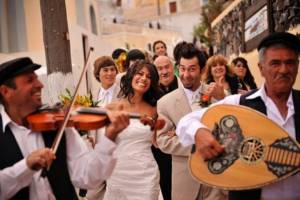
As active entertainment, there are fun competitions, for example, marathon obstacle races, a competition of poets and poetesses, eating the apple of discord without using hands, and so on. It is not necessary to repeat all twelve labors of Hercules, but making guests work and sweat is a mandatory goal.
Greek style wedding menu
Greek weddings are a celebration of the belly. The tables are filled with meat, seafood, cheeses, vegetables, and red wine flows like a river. Of course, a Greek themed wedding requires a special menu! For snacks you can use:
- olives and black olives;
- marinated mushrooms;
- pickles, tomatoes, capers;
- sausage, cheese and cold cuts;
- mini-kebabs of meat and seafood.

Traditional sauces:
- taramasalata;
- tzatziki;
- tahini;
- hummus.
The first and second hot courses, as well as desserts, can be chosen from the list of the most popular Greek dishes or from the menu of the selected restaurant (moussaka, pastitsio, kleftiko). There are many recipes on the Internet in which some unusual ingredients are replaced with those that can easily be found in any Russian supermarket.
A wedding cake

A Greek-style wedding cake can be anything, the main thing is to order a themed design. The rules are still the same: a combination of white and gold colors, greenery as decoration
Ancient Rome
Weddings in Ancient Rome were celebrated noisily and cheerfully. Girls were married off at the age of 14, but there were cases of earlier marriages at the age of 12-13. It was not easy for the ancient Romans to choose a wedding day, since many days were considered unfavorable. Weddings were usually celebrated in the middle or end of June, promising a happy life for the new family.
After the engagement, the bride put the ring on the finger of her left hand. On the same day, a marriage contract was drawn up. After this, the celebration of the wedding itself began. On the night before the wedding, the bride brought all her children's toys to the home altar and said goodbye to them; this ritual symbolized her entry into adult married life. When the wedding day arrived, the bride dressed up in white and red clothes and waited for the groom to arrive.
After the priest clarified whether the wedding day was successful, the marriage contract was signed and the newlyweds took each other’s hands to pray together to the gods. After the ceremony, guests and the newlyweds celebrated the wedding at the bride's house. And only then did the newly made husband and wife go to the house of the head of the family. The groom carried the bride over the threshold of his house in his arms. At this point the wedding celebration ended and family life began.
Music program
Traditional instruments in Greek music are the guitar, harp, violin and flute. You can hire musicians who will dress up in classic costumes and perform Greek tunes, or limit yourself to a selection of music for a DJ.
You don’t have to focus only on the classics; Greece is full of popular bands and performers, for example:
- Nikos Vertis;
- Antonis Remos;
- Thanos Petrelis;
- Eirini Merkouri;
- Nikos Kourkoulis;
- Tamta;
- Haris Alexiou;
- Onirama;
- George Dalaras.

A wedding cake
The main dessert of the holiday can be light - fruity or richer, chocolate. In Greek cuisine, mint and cinnamon are often added to sweets. Be sure to take note of these ingredients. But the wedding cake decorations should match the atmosphere. Columns, beautiful drapery decorated with flowers, a meander - a traditional Greek ornament, or sweet olive and laurel branches are perfect.
Ideas for a photo shoot
A Greek-style wedding photo shoot can be held on the banks of a river, lake or sea to highlight the Mediterranean theme. Also, the following locations should be considered:
- ancient cathedrals;
- buildings with colonnades;
- narrow streets reminiscent of Greece;
- blooming parks and botanical gardens;
- architectural monuments, buildings and museums.

The main emphasis will be on the appearance of the bride and groom, so the photographs will be aesthetic and atmospheric.
Bride and groom - what to wear
If you are having a Greek themed wedding, then the newlyweds need to dress up accordingly:
- for the bride, a floor-length dress made of flowing fabric with a high waist, open shoulders, neck and arms and lots of draperies. This style hides an imperfect figure or a looming tummy and adds a couple of centimeters to your height.;
- for the groom - a toga above the knee with a wide belt and a short cloak. You can skip the helmet. If the groom is not ready to transform into Jason, then you can opt for a light-colored suit, comfortable moccasins and a loose-fitting snow-white shirt.

For decorations, it is better to choose fresh flowers and pearls - let them decorate the dress and the bride’s curls, loose or styled in an intricate braid. You can also decorate your hair with an inlaid hoop, and fasten the veil on the back of your head under the hair knot - in Greece they advise choosing lemon, pink or blue chiffon, which supposedly wards off evil otherworldly forces.
Also, for the newlyweds you need to prepare crowns or at least wreaths made of laurel and olive - you can order artificial ones, with gold leaves. According to ancient Greek tradition, crowns are worn by the bride and groom during the wedding, and removed after the wedding. But many remain in them until the very end of the festivities, and all the guests constantly honor them and give them gifts like a king and queen.
By the way: the Greeks, like the Russians, have a custom of ransoming the bride; she can also be stolen at a wedding. Another tradition is that towards the end of the holiday, a young husband and wife should break a large clay dish for good luck.











